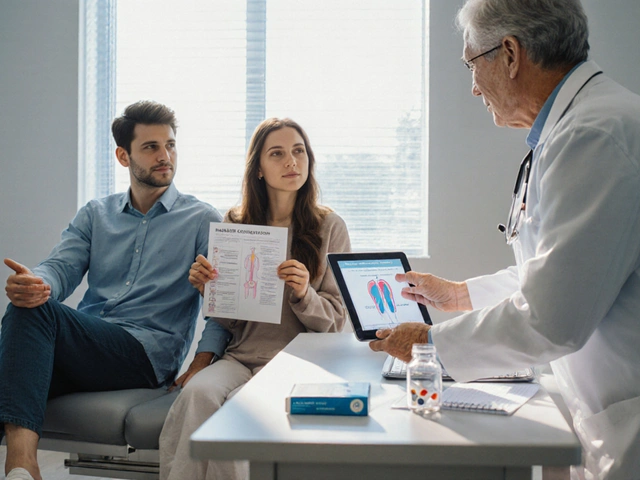Every year, over 20 million people worldwide are diagnosed with carcinoma-the most common type of cancer, starting in the skin or tissue lining organs. But not everyone faces the same risk, or the same chances of survival. Where you’re from, what you look like, and the community you grow up in can shape your cancer journey in ways most people don’t talk about.
Some groups face higher carcinoma risk
Black men in the U.S. are nearly twice as likely to die from prostate carcinoma compared to white men. Asian women have lower rates of breast carcinoma than white women, but higher rates of stomach and liver carcinoma. Hispanic populations in the U.S. are more likely to be diagnosed with cervical carcinoma at later stages. These aren’t random patterns. They’re tied to biology, environment, and access.
Genetics play a role. For example, BRCA1 and BRCA2 mutations-strongly linked to breast and ovarian carcinoma-are more common in people of Ashkenazi Jewish descent. African ancestry is tied to more aggressive forms of prostate carcinoma, with tumors that grow faster and spread earlier. In East Asia, stomach carcinoma rates remain high due to long-standing dietary habits and high rates of H. pylori infection, which is more prevalent in certain ethnic groups.
But genes alone don’t explain it. Skin carcinoma rates are rising fastest among Hispanic populations in the U.S., not because they have less melanin, but because public health messaging has historically targeted lighter-skinned groups. Many don’t realize darker skin can burn, or that melanoma can show up under nails or on the soles of feet. When it’s missed, it’s often diagnosed too late.
Access to screening changes everything
Colon carcinoma is one of the most preventable cancers-if you get screened. But in the U.S., Black adults are 20% less likely to get a colonoscopy than white adults by age 50. Why? Transportation issues. Lack of paid time off. Mistrust in the medical system after decades of exploitation, like the Tuskegee Syphilis Study. Language barriers for non-English speakers. These aren’t just "inconveniences." They’re roadblocks that lead to late-stage diagnoses.
Same goes for cervical carcinoma. In rural areas of India, where Pap smears are rare, the disease kills more women than breast cancer. In Australia, Aboriginal women are 2.5 times more likely to die from cervical carcinoma than non-Indigenous women. The HPV vaccine is available-but outreach in remote communities is inconsistent. Vaccination rates there are half those in major cities.
Screening isn’t just about having a test. It’s about knowing you need it, being able to get it, and trusting that someone will take you seriously when you say something’s wrong.
Treatment isn’t the same for everyone
Even when diagnosed at the same stage, outcomes vary. A 2023 study in the Journal of Clinical Oncology found that Black patients with lung carcinoma were 15% less likely to receive surgery, even when they were medically eligible. Latino patients with breast carcinoma were 30% less likely to get recommended chemotherapy. In many cases, doctors assumed they couldn’t handle the side effects-or didn’t explain the options clearly.
Language matters. A Spanish-speaking patient might hear "chemotherapy" as "strong medicine," not realize it’s meant to shrink tumors before surgery. A Vietnamese woman might avoid telling her doctor about unusual bleeding because she believes it’s "women’s business," not something to discuss with a man. Cultural norms shape how people talk-and don’t talk-about cancer.
And then there’s the cost. In countries without universal healthcare, out-of-pocket expenses can force people to skip treatments. A 2024 analysis in Australia showed that Indigenous patients with head and neck carcinoma were three times more likely to stop radiation therapy early because of travel costs to urban treatment centers. No one should have to choose between paying for gas and staying alive.

Biased algorithms make things worse
Here’s something most patients don’t know: many hospitals use AI tools to predict who needs more aggressive care. But if those tools are trained mostly on data from white patients, they’ll get it wrong for others.
A 2019 study from Stanford found a widely used algorithm in U.S. hospitals underestimated the health needs of Black patients. It used past healthcare spending as a proxy for illness. But because Black patients have historically had less access to care, they spent less-so the algorithm labeled them as less sick, even when they had the same conditions. That meant fewer were referred for extra support, including cancer screenings or specialist care.
These tools are still in use today. And they’re not just in the U.S. Similar biases show up in European and Australian health systems where data lacks diversity. If your skin tone isn’t in the training set, the system doesn’t know how to read your symptoms.
What’s being done-and what still needs to change
Some places are making progress. In Australia, the National Aboriginal Community Controlled Health Organisation runs mobile screening units in remote areas. In the U.K., cancer charities now offer multilingual patient navigators. In Brazil, community health workers are trained to spot early signs of skin carcinoma in darker skin tones.
But systemic change is slow. We need more diverse clinical trials. Right now, over 75% of participants in U.S. cancer trials are white. That means drugs approved based on those trials might not work as well-or have unexpected side effects-in other groups.
We need doctors trained in cultural humility, not just cultural competence. It’s not enough to know that some cultures avoid eye contact. You need to ask: "What do you believe is causing this? What are you afraid of? Who do you want making decisions with you?"
And we need data. Governments and hospitals must collect race and ethnicity data-not to label people, but to fix gaps. Without it, we’re flying blind.

What you can do
If you’re a patient: ask questions. Don’t let anyone tell you your symptoms are "normal" or "just stress." Push for a second opinion. Bring someone with you to appointments. Record the conversation if you’re allowed.
If you’re a caregiver: learn the signs of carcinoma in your community’s skin tone. Know which screenings are recommended for your background. Don’t wait for symptoms. Early detection saves lives.
If you’re part of a community organization: partner with local clinics. Host free screening events. Translate materials. Challenge myths. A grandmother who believes cancer is contagious won’t go to the doctor. But if a trusted neighbor explains it’s not contagious-and shows her someone who beat it-she might.
Cancer doesn’t care about your race. But the system does. And until we fix that, outcomes will stay unequal.
Why do some ethnic groups have higher carcinoma rates?
Higher rates aren’t caused by race itself, but by a mix of genetic factors, environmental exposures, cultural norms, and unequal access to care. For example, African ancestry is linked to more aggressive prostate carcinoma, while diets high in salted fish and H. pylori infection raise stomach carcinoma risk in East Asian populations. Lack of screening and delayed diagnosis due to systemic barriers also play major roles.
Does skin color affect skin carcinoma risk?
Yes, but not in the way most people think. While lighter skin has less natural protection from UV rays, people with darker skin are often diagnosed later because skin carcinoma can appear in less obvious places-like under nails, on palms, or soles of feet. Public health campaigns have long focused on fair-skinned groups, leaving others unaware. When detected late, survival rates drop sharply across all skin tones.
Are cancer treatments less effective for certain races?
Treatments themselves aren’t inherently less effective. But they’re often not offered equally. Studies show Black and Latino patients are less likely to receive surgery, chemotherapy, or targeted therapies-even when medically eligible. Language barriers, provider bias, and mistrust in the system lead to under-treatment. Also, most clinical trials include mostly white participants, so drug responses in other groups aren’t fully understood.
Can genetic testing help identify higher risk?
Yes, for some. People with Ashkenazi Jewish heritage have a higher chance of carrying BRCA mutations linked to breast and ovarian carcinoma. African ancestry is associated with more aggressive prostate carcinoma subtypes. But genetic testing isn’t widely offered to everyone who might benefit. Access depends on income, location, and whether your doctor knows to recommend it. Testing should be part of routine care for high-risk groups-not a luxury.
How can I find culturally appropriate cancer care?
Look for community health centers, hospitals with interpreter services, or nonprofit organizations that serve your ethnic group. In Australia, Aboriginal Community Controlled Health Services offer culturally safe care. In the U.S., organizations like the National Cancer Institute’s Minority Health and Health Equity office list resources. Ask if your provider has experience treating patients from your background. Don’t settle for a provider who dismisses your concerns or doesn’t speak your language.
What’s next for equity in carcinoma care
The science is clear: cancer outcomes are shaped by more than biology. They’re shaped by history, policy, and power. Fixing this won’t happen with better drugs alone. It needs better systems-ones that listen, adapt, and include everyone.
When a Black woman in Atlanta, a Vietnamese woman in Sydney, and a Navajo man in Arizona all get the same chance to survive carcinoma-that’s when we’ll know the system is finally working for everyone.






Tara Stelluti
November 18, 2025 at 17:29
Okay but let’s be real - the system is rigged. I work in public health and see this daily. Black patients get told to 'come back in a few weeks' while white patients get MRIs the same day. It’s not about genetics. It’s about who the system thinks is worth saving.
And don’t even get me started on AI tools that use spending as a proxy for need. That’s not bias - that’s institutional cruelty dressed up as data.